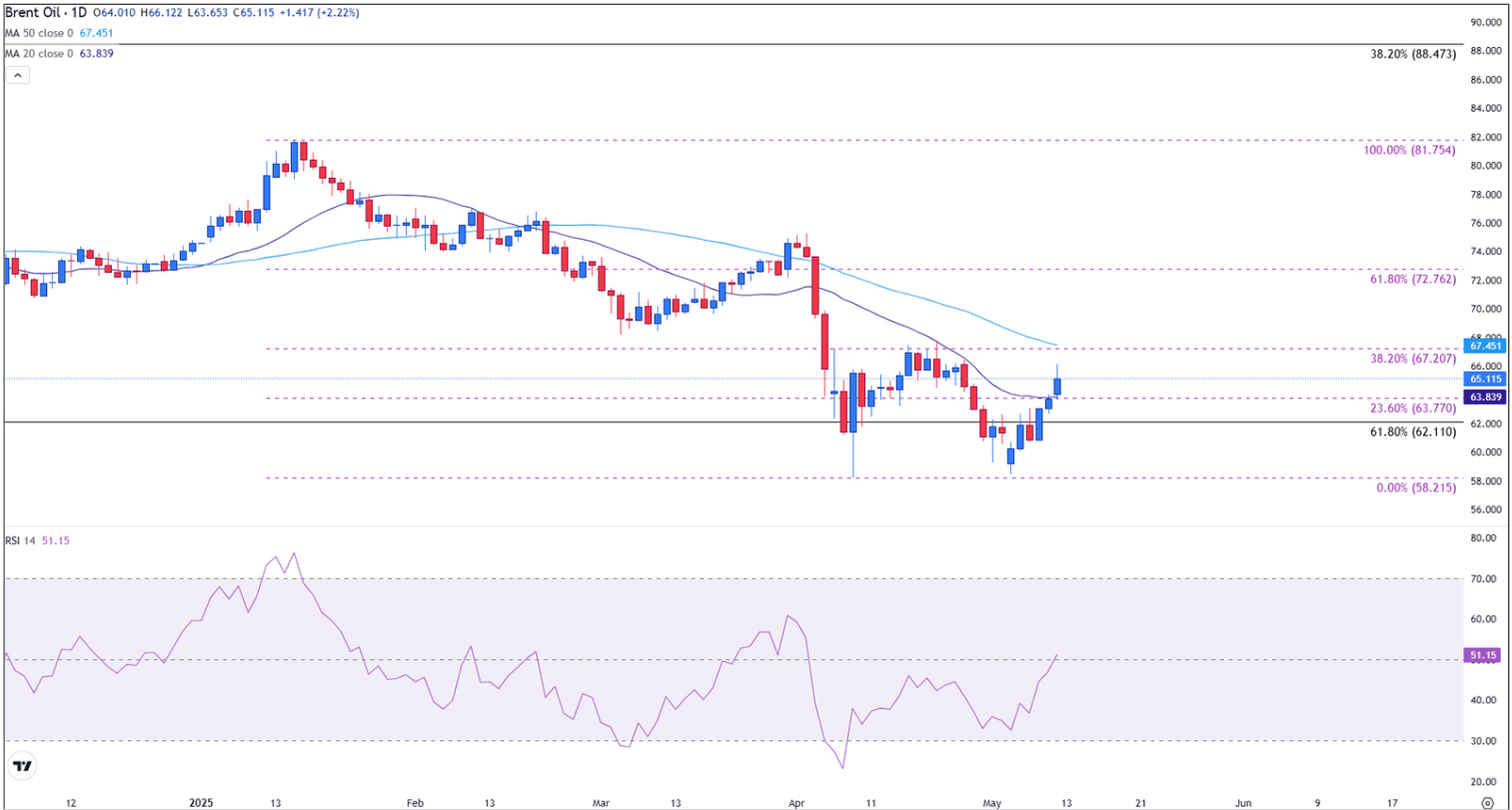- Brent crude oil is quoted above $ 65 per barrel, winning more than 2% in Monday’s session
- The suspension of 90 -day tariffs between the US and China supports the appetite for risk
- The market approach moves to the US CPI and the inventory data on Tuesday to obtain more directional clues
Brent crude oil has expanded its profits at the beginning of the negotiation week, driven by temporary relief in geopolitical tensions and an improvement in macroeconomic feeling.
At the time of the publication, the Brent is quoted at approximately $ 65,40 per barrel, marking a gain of 2.37% in the day. This movement follows an agreement between the United States (USA) and China to reduce and suspend certain tariffs for a period of 90 days, an initiative widely seen as a decalsed of commercial hostilities and a possible catalyst for global economic stabilization.
The bilateral tariff truce is currently the main engine of appetite due to the risk in raw materials and actions. China, as one of the largest crude oil importers linked to the Brent, will benefit directly from more favorable commercial conditions, thus reinforcing demand expectations. It is expected that the suspension of tariffs support the cross -border industrial activity and fuel intensive sectors such as manufacturing, logistics and transport, all key components of global oil consumption.
Although the agreement is temporary and may be subject to renegotiation or reversal, its immediate impact has been to reduce the fears of a global economic deceleration. This improvement in feeling has translated into a generalized strength in risk -sensitive assets, including crude oil.
IPC data and US inventory reports will guide the Brent price trajectory
The Brent’s short -term address now depends on the next key data launches, with the operators closely monitoring the indicators that could impact demand expectations and the feeling of the market in general.
It is expected that the US Consumer Price Index (CPI) on Tuesday will play a fundamental role. As a critical indicator of inflation, the CPI influences the expectations of the Federal Reserve Policy (FED).
A stronger inflation fact could reinforce the expectations of a prolonged restrictive posture by the Fed, which could exert down the crude oil by strengthening the US dollar and reducing demand.
On the contrary, a softer reading of the CPI could boost raw materials by supporting the feeling of risk.
In addition, crude oil operators will be attentive to this week’s inventory data in search of signs of strength in the underlying demand.
The American Petroleum Institute (API) is scheduled to publish its weekly report on Tuesday, followed by the US ERY INFORMATION ADMINISTRATION DATA (EIA) on Wednesday.
Although these reports refer mainly to the West Texas Intermediate (WTI), their implications for US consumption patterns and market balance remain very relevant for the Brent price setting.
A decrease greater than anticipated in inventories would suggest more adjusted supply conditions and could provide additional impulse to the Brent. On the other hand, a surprising increase could moderate recent profits by pointing out an excess of supply.
Brent crude oil faces psychological resistance by $ 66
Brent crude oil briefly rose to a maximum session of $ 66,87 during European trade early before slightly cutting the profits.
This movement pushed prices above the simple mobile average (SMA) of 20 days in $ 63.84 and approached, but did not exceed, the fibonacci setback of 38.2% of the 2025 movement, at 67.21 $.
The 50 -day SMA at $ 67.45 also remains without trying, acting as a significant technical roof.
Brent crude oil daily chart

The immediate resistance is now seen at $ 66.87, with a stronger resistance between $ 67.20 and $ 67.45, an area that combines fibonacci and mobile socks. A rupture confirmed above this range would probably open the door towards $ 69.98, which represents the 50% decline in the accumulated fall to date and is closely aligned with the psychological threshold of 70.00 $.
At the bottom, the first support is found in the 20 -day SMA ($ 63.84), followed by a more significant support in the fibonacci setback from 61.8% to $ 62.11, measured from the minimum of April 2020 to the maximum of March 2022.
The relative force index (RSI) in the daily chart remains about 51, suggesting a neutral momentum with potential for more increases if key resistance levels are exceeded. The Brent remains within a short -term recovery channel, although sustained profits would be needed above the 50 -day SMA to confirm a break.
Brent Faqs crude oil
Brent crude oil is a type of crude oil found in the North Sea and is used as a reference point for international oil prices. It is considered “light” and “sweet” due to its high gravity and low sulfur content, which facilitates its refining to turn it into gasoline and other high value products. Brent crude oil serves as a reference price for approximately two thirds of internationally marketed oil supplies in the world. Its popularity is based on its availability and stability: the North Sea region has a well -established infrastructure for oil production and transport, which guarantees reliable and constant supply.
Like all assets, supply and demand are the key drivers of the price of crude oil Brent. As such, global growth can be an engine of greater demand and vice versa for weak global growth. Political instability, wars and sanctions can alter the offer and affect prices. OPEC decisions, a group of important oil -producing countries, are another key price factor. The value of the US dollar influences the price of Brent crude oil, since oil is predominantly marketed in US dollars, so a weaker US dollar can make oil more affordable and vice versa.
Weekly reports of oil inventories published by the American Petroleum Institute (API) and the Energy Information Agency (EIA) impact the price of Brent crude oil. Changes in inventories reflect the fluctuation of supply and demand. If the data shows a drop in inventories, it can indicate an increase in demand, which makes the price of oil rise. The greatest inventories can reflect an increase in supply, which makes prices lower. The API report is published every Tuesday and that of EIA the next day. Their results are usually similar, with a 1% difference from each other 75% of the time. EIA data is considered more reliable, since it is a government agency.
OPEC (Organization of Petroleum Exporting Countries) is a group of 13 oil -producing nations that collectively decide production quotas for member countries in semiannual meetings. Your decisions often affect Brent crude oil prices. When OPEC decides to reduce quotas, it can restrict the supply, uploading oil prices. When OPEC increases production, it has the opposite effect. The OPEC+ refers to an expanded group that includes ten additional members that do not belong to the OPEC, the most notable of which Russia is.
Source: Fx Street
I am Joshua Winder, a senior-level journalist and editor at World Stock Market. I specialize in covering news related to the stock market and economic trends. With more than 8 years of experience in this field, I have become an expert in financial reporting.







